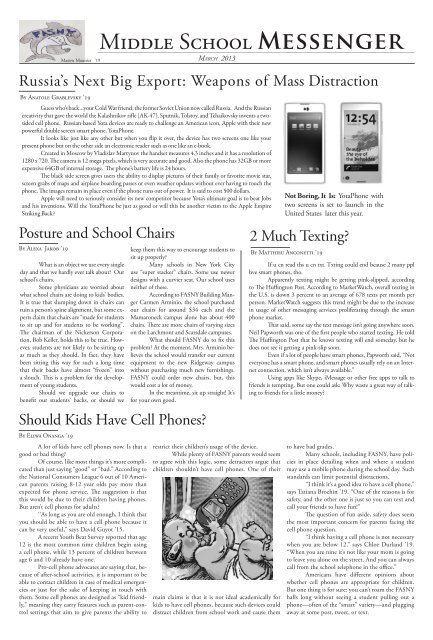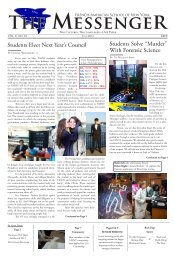ThE MESSENGER - Franco-American School of New York
ThE MESSENGER - Franco-American School of New York
ThE MESSENGER - Franco-American School of New York
- No tags were found...
You also want an ePaper? Increase the reach of your titles
YUMPU automatically turns print PDFs into web optimized ePapers that Google loves.
Middle <strong>School</strong> Messenger<br />
Maxim Mounier ‘19<br />
Ma rc h 2013<br />
Russia’s Next Big Export: Weapons <strong>of</strong> Mass Distraction<br />
By Anatole Grablevsky ’19<br />
Guess who’s back…your Cold War friend; the former Soviet Union now called Russia. And the Russian<br />
creativity that gave the world the Kalashnikov rifle (AK-47), Sputnik, Tolstoy, and Tchaikovsky invents a twosided<br />
cell phone. Russian-based Yota devices are ready to challenge an <strong>American</strong> icon, Apple with their new<br />
powerful double screen smart phone, YotaPhone.<br />
It looks like just like any other but when you flip it over, the device has two screens one like your<br />
present phone but on the other side an electronic reader such as one like an e-book.<br />
Created in Moscow by Vladislav Martynov the handset measures 4.3 inches and it has a resolution <strong>of</strong><br />
1280 x 720. The camera is 12 mega pixels, which is very accurate and good. Also the phone has 32GB or more<br />
expensive 64GB <strong>of</strong> internal storage. The phone’s battery life is 24 hours.<br />
The black side screen gives users the ability to display pictures <strong>of</strong> their family or favorite movie star,<br />
screen grabs <strong>of</strong> maps and airplane boarding passes or even weather updates without ever having to touch the<br />
phone. The images remain in place even if the phone runs out <strong>of</strong> power. It is said to cost 500 dollars.<br />
Apple will need to seriously consider its new competitor because Yota’s ultimate goal is to beat Jobs<br />
and his inventions. Will the YotaPhone be just as good or will this be another victim to the Apple Empire<br />
Striking Back<br />
Posture and <strong>School</strong> Chairs<br />
By Alexa Jakob ’19<br />
What is an object we use every single<br />
day and that we hardly ever talk about Our<br />
school’s chairs.<br />
Some physicians are worried about<br />
what school chairs are doing to kids’ bodies.<br />
It is true that slumping down in chairs can<br />
ruin a person’s spine alignment, but some experts<br />
claim that chairs are “made for students<br />
to sit up and for students to be working”.<br />
The chairman <strong>of</strong> the Nickerson Corporation,<br />
Bob Keller, holds this to be true. However,<br />
students are not likely to be sitting up<br />
as much as they should. In fact, they have<br />
been sitting this way for such a long time<br />
that their backs have almost “frozen” into<br />
a slouch. This is a problem for the development<br />
<strong>of</strong> young students.<br />
Should we upgrade our chairs to<br />
benefit our students’ backs, or should we<br />
A lot <strong>of</strong> kids have cell phones now. Is that a<br />
good or bad thing<br />
Of course, like most things it’s more complicated<br />
than just saying “good” or “bad.” According to<br />
the National Consumers League 6 out <strong>of</strong> 10 <strong>American</strong><br />
parents raising 8-12 year olds pay more than<br />
expected for phone service. The suggestion is that<br />
this would be due to their children having phones.<br />
But aren’t cell phones for adults<br />
‘’As long as you are old enough, I think that<br />
you should be able to have a cell phone because it<br />
can be very useful,’’ says David Guyot ’15.<br />
A recent Youth Beat Survey reported that age<br />
12 is the most common time children begin using<br />
a cell phone, while 13 percent <strong>of</strong> children between<br />
age 6 and 10 already have one.<br />
Pro-cell phone advocates are saying that, because<br />
<strong>of</strong> after-school activities, it is important to be<br />
able to contact children in case <strong>of</strong> medical emergencies<br />
or just for the sake <strong>of</strong> keeping in touch with<br />
them. Some cell phones are designed as “kid friendly,”<br />
meaning they carry features such as parent-control<br />
settings that aim to give parents the ability to<br />
keep them this way to encourage students to<br />
sit up properly<br />
Many schools in <strong>New</strong> <strong>York</strong> City<br />
use “super stacker” chairs. Some use newer<br />
designs with a curvier seat. Our school uses<br />
neither <strong>of</strong> these.<br />
According to FASNY Building Manger<br />
Carmen Arminio, the school purchased<br />
our chairs for around $34 each and the<br />
Mamaroneck campus alone has about 400<br />
chairs. There are more chairs <strong>of</strong> varying sizes<br />
on the Larchmont and Scarsdale campuses.<br />
What should FASNY do to fix this<br />
problem At the moment, Mrs. Arminio believes<br />
the school would transfer our current<br />
equipment to the new Ridgeway campus<br />
without purchasing much new furnishings.<br />
FASNY could order new chairs, but, this<br />
would cost a lot <strong>of</strong> money.<br />
In the meantime, sit up straight! It’s<br />
for your own good.<br />
Should Kids Have Cell Phones<br />
By Eliwa Onanga ’19<br />
restrict their children’s usage <strong>of</strong> the device.<br />
While plenty <strong>of</strong> FASNY parents would seem<br />
to agree with this logic, some detractors argue that<br />
children shouldn’t have cell phones. One <strong>of</strong> their<br />
main claims is that it is not ideal academically for<br />
kids to have cell phones, because such devices could<br />
distract children from school work and cause them<br />
Not Boring, It Is: YotaPhone with<br />
two screens is set to launch in the<br />
United States later this year.<br />
2 Much Texting<br />
By Matthieu Anconetti ’19<br />
If u cn read ths u cn txt. Txting could end bcause 2 many ppl<br />
hve smart phones, tho.<br />
Apparently texting might be getting pink-slipped, according<br />
to The Huffington Post. According to MarketWatch, overall texting in<br />
the U.S. is down 3 percent to an average <strong>of</strong> 678 texts per month per<br />
person. MarketWatch suggests this trend might be due to the increase<br />
in usage <strong>of</strong> other messaging services proliferating through the smart<br />
phone market.<br />
That said, some say the text message isn’t going anywhere soon.<br />
Neil Papworth was one <strong>of</strong> the first people who started texting. He told<br />
The Huffington Post that he knows texting will end someday, but he<br />
does not see it getting a pink-slip soon.<br />
Even if a lot <strong>of</strong> people have smart phones, Papworth said, “Not<br />
everyone has a smart phone, and smart phones usually rely on an Internet<br />
connection, which isn’t always available.”<br />
Using apps like Skype, iMessage or other free apps to talk to<br />
friends is tempting. But one could ask: Why waste a great way <strong>of</strong> talking<br />
to friends for a little money<br />
to have bad grades.<br />
Many schools, including FASNY, have policies<br />
in place detailing when and where a student<br />
may use a mobile phone during the school day. Such<br />
standards can limit potential distractions.<br />
“I think it’s a good idea to have a cell phone,”<br />
says Tatiana Brochin ’19. “One <strong>of</strong> the reasons is for<br />
safety, and the other one is just so you can text and<br />
call your friends to have fun!”<br />
The question <strong>of</strong> fun aside, safety does seem<br />
the most important concern for parents facing the<br />
cell phone question.<br />
“I think having a cell phone is not necessary<br />
when you are below 12,” says Chloe Durland ’19.<br />
“When you are nine it’s not like your mom is going<br />
to leave you alone on the street. And you can always<br />
call from the school telephone in the <strong>of</strong>fice.”<br />
<strong>American</strong>s have different opinions about<br />
whether cell phones are appropriate for children.<br />
But one thing is for sure: you can’t roam the FASNY<br />
halls long without seeing a student pulling out a<br />
phone—<strong>of</strong>ten <strong>of</strong> the “smart” variety—and plugging<br />
away at some post, tweet, or text.
















